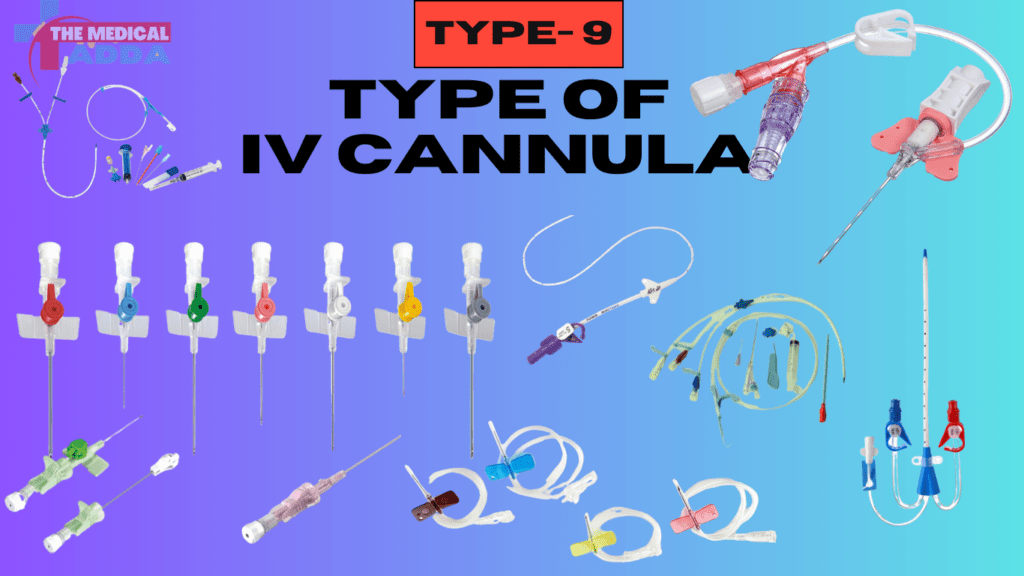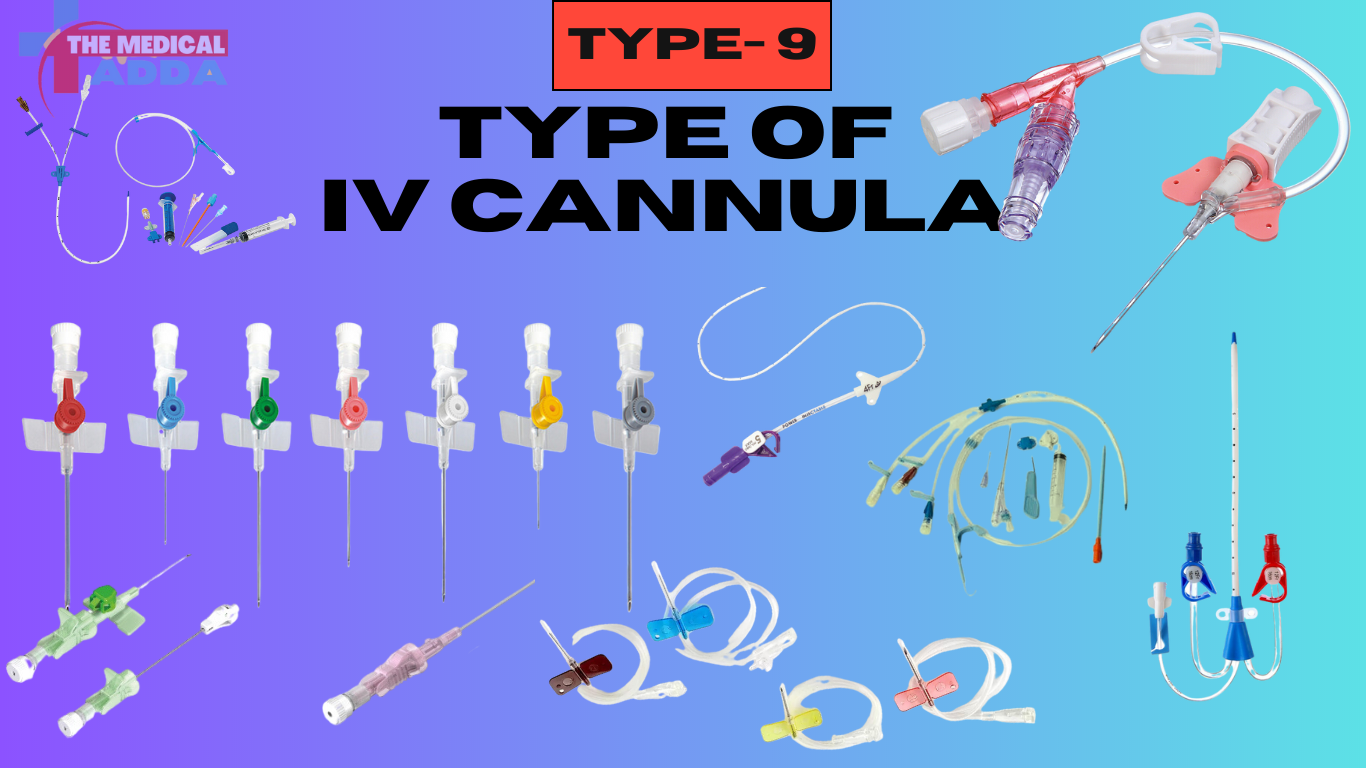Introduction:
Intravenous (IV) cannulas, also known as IV Cannula / IV Catheter, play a crucial role in modern healthcare, allowing for the administration of fluids, medications, and blood products directly into the bloodstream. However, not all IV cannulas are the same, as different types are designed to meet specific patient needs and medical requirements. This article will explore the various iv cannula types, their features, benefits, and appropriate applications.

Types of IV Cannula:
1.Peripheral IV Cannula:
peripheral intravenous cannula is The most commonly used type of IV cannula, inserted into a peripheral vein, typically in the arm.
Features: Available in different sizes (gauge), ranging from 14G to 26G. Smaller gauge sizes are used for fragile veins or pediatric patients, while larger sizes are used for rapid fluid administration.
Benefits: Easy to insert, cost-effective, and suitable for short-term therapy.

2.Midline IV Cannula:
Description: A longer cannula inserted into a peripheral vein, with the tip extending near the axilla (armpit).
Features: Sizes usually range from 3 inches to 8 inches, allowing for deeper vein access and more extended therapy.
Benefits: Suitable for patients requiring longer-term therapy (up to 4 weeks) and for administering vesicant medications that may cause tissue damage if extravasation occurs.

3. Central Venous Catheter (CVC):
Description: A catheter inserted into a large vein in the neck, chest, or groin region, providing access to the central venous system.
Features: Multiple lumens allow for the simultaneous administration of fluids, medications, and blood products. Types include tunneled, non-tunneled, and peripherally inserted central catheters (PICC lines).
Benefits: Suitable for long-term therapy, administration of hypertonic solutions, chemotherapy, and hemodialysis.

4. Peripherally Inserted Central Catheter (PICC):
Description: A long catheter inserted into a peripheral vein, which is then threaded through the vein until the tip reaches a central vein.
Features: Radiopaque material aids in proper placement visualization during X-rays. PICCs typically have a single or double lumen.
Benefits: Provides a safer alternative to CVCs, reducing the risk of complications associated with central line placement. Suitable for patients requiring long-term intravenous therapy.

5. Winged Infusion Set (Butterfly):
Description: A smaller-sized cannula with flexible wings attached, resembling a butterfly shape.
Features: The wings allow for better control and stability during insertion. It is commonly used for patients with small or fragile veins, such as pediatric or elderly individuals.
Benefits: Provides a more precise and controlled insertion, reducing the risk of vein damage and improving patient comfort.

6. Safety IV Cannula:
Description: A cannula designed with additional safety features to minimize accidental needlestick injuries.
Features: Various safety mechanisms, such as retractable needles, sliding shields, or self-sealing valves, are incorporated to protect healthcare professionals during insertion or removal.
Benefits: Enhances healthcare worker safety, reduces the risk of bloodborne infections, and promotes compliance with safety protocols.

7. Winged Infusion Set with Blood Sampling Port:
Description: A butterfly-style cannula with an additional port for blood sampling without the need for additional needle insertion.
Features: The blood sampling port allows for convenient and aseptic collection of blood samples while the cannula remains in place for fluid or medication administration.
Benefits: Reduces patient discomfort by minimizing the need for repeated needle insertions for blood sampling, particularly in patients requiring frequent blood tests.

8. Arterial IV Cannula:
Description: A specialized cannula designed for arterial access, allowing for continuous monitoring of arterial blood pressure and blood gas analysis.
Features: The cannula has a stiffer construction and a needle bevel specifically designed for arterial puncture.
Benefits: Facilitates accurate and continuous arterial monitoring, essential in critical care settings and during certain surgical procedures.

9. Hemodialysis Catheter:
Description: A catheter specifically designed for hemodialysis, allowing for the removal and return of blood during renal replacement therapy.
Features: Usually, have two lumens, one for blood withdrawal and the other for blood return. The catheter is inserted into a large vein, often in the neck or groin region.
Benefits: Provides reliable and efficient access for hemodialysis treatment, reducing the need for repeated needle insertions for patients requiring regular dialysis sessions.
By understanding the features, benefits, and appropriate applications of these additional types of IV cannulas, healthcare professionals can tailor their choices to meet specific patient needs and optimize the delivery of intravenous therapy.

Conclusion:
Intravenous cannulas, also known as IV catheters, come in various types to cater to different medical needs and patient requirements. Whether it’s a peripheral IV cannula for short-term therapy, a midline IV cannula for extended therapy, a central venous catheter for specialized treatments, or a peripherally inserted central catheter for long-term therapy, each type of iv cannula uses and serves a unique purpose in delivering fluids, medications, and blood products safely and effectively.
Selecting the right IV cannula involves considering factors such as patient age, condition, and treatment duration. Healthcare professionals should follow sterile techniques and step of procedure when inserting cannulas and adhere to institutional guidelines regarding cannula change frequency. By ensuring proper site care, monitoring, and adherence to aseptic practices, the risk of complications, such as infection or thrombosis, can be minimized.
Understanding the different types of IV cannulas empowers healthcare providers to make informed decisions and provide optimal care to patients requiring intravenous therapy. By utilizing the appropriate IV cannula for each situation, healthcare professionals can enhance patient comfort, improve treatment outcomes, and promote overall safety in healthcare settings
FAQs (Frequently Asked Questions):
Q1. How is an IV cannula inserted?
A1. iv cannula insertion by a trained healthcare professional using a sterile technique. The chosen vein is punctured using a needle, and once blood return is confirmed, the cannula is advanced into the vein over the needle. you can read our article regarding iv cannulation tips and tricks for painless experience
Q2. How often should IV cannulas be changed?
A2. The frequency of IV cannula change depends on various factors, including the patient’s condition, the type of cannula, and institutional guidelines. Generally, peripheral IV cannulas are changed every 72 to 96 hours, while CVCs and PICCs may remain in place for weeks or months.
Q3. What are the complications associated with IV cannulas?
A3. Potential complications include infection, infiltration, phlebitis, thrombosis, and air embolism. Proper site care, monitoring, and adherence to aseptic techniques can minimize these risks.

Great topic, please keep it up I really enjoy reading these type articles.